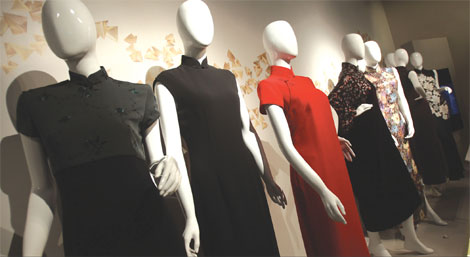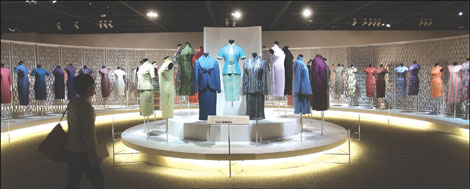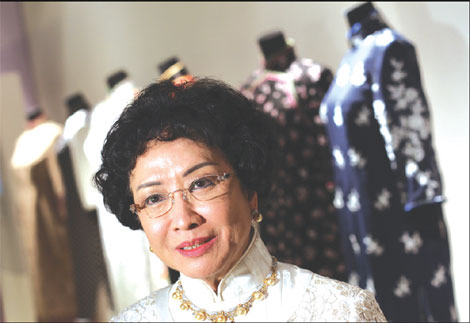The qipao: capturing the Eternal Feminine
Updated: 2010-07-07 07:37
By Phoebe Cheng(HK Edition)
|
|||||||
|
Qipao designs from Blanc de Chine are shown at a recent exhibition, called "The Evergreen Classic - Transformation of the Qipao". The pieces from the luxury fashion brand have incorporated contemporary fashion elements with the traditional Chinese garment. Edmond Tang / China Daily |
|
The qipao exhibition features more than 270 traditional garments, many of which have been worn by legendary actresses and other celebrities. Edmond Tang / China Daily |
|
Historical qipao photos are also displayed at the exhibition. Edmond Tang / China Daily |
|
Vera Waters, a collector of the qipao, says she has been wearing qipao since she was a student. Edmond Tang / China Daily |
It's rare that a fashion endures for nearly 400 years. But the qipao, in the four centuries since it came down from Manchuria, has changed with the times, so that today it remains an iconic symbol of Chinese elegance and femininity. Phoebe Cheng reports.
In the long ago dream of Kin Yeung, he saw himself introducing Chinese culture to the world: its art, history, philosophy, and all the cultural values of Zen Buddhism, Taoism and Confucianism. And in his dream he would accomplish this through contemporary fashion.
That's how the luxury fashion brand Blanc de Chine started, back in 1986.
One finds Yeung in his shop in the Landmark, in Central. A modest man of sixty-something - in a black shirt and single pleated black trousers - his own design, he flips through the garment rack, selecting a qipao, then holds it aloft for examination.
"Dignity, inner beauty, never emphasizes exposing the body," Yeung said. "Old fashion pauses at a point in the timeline and never moves on," he mused.
"Modern fashion takes reference from a point in the past and transforms it into today's lifestyle, just like our Chinese culture. People think Chinese teachings and culture are old-fashioned. They are people who don't have confidence in the culture. They never apply the traditions to make them relevant for today."
He looks around at his designs hanging in the shop, "so ancient, yet so modern". He agrees fashion anywhere must derive from its culture.
He takes his own inspirations from the classical qipao and from traditional Chinese teachings. Then he modernizes them and creates gowns for the present.
The modern qipao, emerged from Shanghai, in the early part of the 20th century. It was adapted from a traditional garment that came to China during the early Qing Dynasty (1644-1911).
The qipao is tightly fitted with a mandarin collar with slits on either side along the hem.
Incorporating contemporary fashion elements with the traditional garment, Yeung revises the garment with sparkling patterns and popular designs. One of the designs from his "Travel" series is a qipao made from double-sided jersey. It's light weight and has a soft texture. The dress can be worn in the traditional way, as a long dress. It can also be worn as a short dress, a skirt and even a T-shirt. Yeung calls it "Interactive Dress." He's designed it for the convenience of contemporary Hong Kong people.
Some other examples are the see-through qipao, made with netted shell fabric and closed with knot-shaped buttons to embody the quintessential qualities of the modern woman. Another piece is covered with red sequins, rhinestones at the collar and side slits. It was worn by the late Anita Mui when the singer performed a 2003 concert.
A recent exhibition, called "The Evergreen Classic - Transformation of the Qipao", featured a dozen designs from Blanc de Chine.
One of Yeung's pieces shown at the exhibition was a black qipao. It was the simplest and most classic design and a favorite of the company's chief operating officer, Davie Mok.
"The simpler the piece looks, the more difficult for the tailor to make the qipao," Mok said. "It all depends on the handwork, the design, and even the material used that make the qipao a great piece to wear."
Mok thinks a real qipao should describe the inner beauty of Chinese women. That inner beauty, says Mok, encompasses their implicitness, subtleness, and intelligence inside and outside, without emphasizing exposed skin. This is among the principles that should apply to the design of every good qipao.
The dress caught the attention of the West, when actress Nancy Kwan, who was cast in the role of a Wan Chai bar girl, wore a qipao in the 1960s film, The World of Suzie Wong. Mok didn't care for the representation of the dress in the film. He found the costumes crass, overshadowing the natural inner beauty of women with excessive exposure of bare flesh.
"They (qipao) are feminine and sexy without being too explosive. There is a class or a quality about the qipao that complements Chinese women. They are just a beautiful combination. It shows off the slender figure too. They make every Chinese woman look beautiful," said professor Lorraine Justice, Director of the School of Design of the Hong Kong Polytechnic University. She is fascinated by the transformation of the garments throughout their history.
"It has come down through history with influences of the Manchurian. Changes to the costume over the years have been just fabulous because they really show the exquisiteness of Chinese women who wear it. It was just beautiful."
Gwen Kao, wife of Nobel laureate Charles Kao, worn a bluish purple qipao at the Nobel Prize Award ceremony in 2009. Qipao is also a popular choice for celebrities to be worn at international occasions to show a sign of Chinese. Actress Michelle Yeoh Choo Kheng wore a qipao covered with shining tawny beads when she attended the Festival de Cannes.
Vera Waters, 74, is a collector of the qipao with about 350 pieces in her wardrobe. Each has its own accessories of the same color and tone. She says she's been wearing qipao since she was a student. As a Chinese, she says she is proud to wear the garment, to represent the culture of her people.
"I wear qipao because I am a Chinese," said Waters whose husband is British. "My husband will see me wearing a different style of qipao everyday."
Waters says she learned to appreciate the beauty of the style when she traveled abroad.
"Western fashion design is eye-catching because of the exposure of flesh and the remarkable features added but qipao depends very much on the figure of the person."
Waters is still wearing the qipao today. She calls the fashion timeless. Not just that, she says a dress made 20 years ago still can be worn today, as long as the body shape remains basically unchanged.
"Because of the fitting, you'll notice once when the dress makes you feel tight. This is when you have to control your diet. It thus helps you keep fit," Waters said with a laugh.
She is perturbed by the fact that it is more difficult to find a good tailor these days. Her tailor of many years, now in his 70s is about to retire.
"Generally it takes about three days for an experienced tailor to make a quality qipao which costs about HK$2,500. Fewer tailors are willing to spend that much time for such a low return."
To renovate the traditional garment in today's society, professor Justice thinks designers have to play with it.
"The fashion of today does allow people to have a lot more fun through the different things they can choose and they can show their personalities more through the clothes and things they choose. It is all about self-expression in a very loud way and about individuality and in a way that is attention getting," Justice said. "But the qipao is a way to quietly show beauty without calling for attention or inviting certain things."
She suggested a shorter qipao is more suited to modern culture.
"Maybe alter them a bit, or have fun with today's fabrics. Maybe they can be cut a bit differently because women's bodies today are a little bit different."
To Yeung, fashion is a way to represent individuality, but it's also a channel for keeping the younger generation in touch with the traditions of modesty, gentleness and elegance.
"We Hong Kong people, especially the younger generation, should recognize our national culture. We have to show our national spirit," he said.
(HK Edition 07/07/2010 page4)



